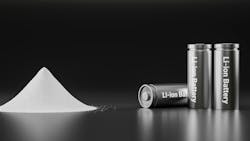Barry on Batteries: The Chemical Engineer's Guide to Battery Recycling Innovation
3 Key Takeaways
- Battery recycling is evolving beyond traditional methods, with "direct" recycling emerging as a promising alternative to hydrometallurgical processes - using physical separation techniques like gravity separation and froth flotation to preserve cathode active materials' electrochemical properties.
- Researchers are exploring diverse chemical agents for more efficient recycling - from novel acid mixtures to bio-leaching agents and bacteria - each requiring specialized mixing, solid-liquid separation, and drying technologies for optimal processing.
- Previously overlooked materials like manganese and graphite are gaining attention in the recycling landscape, presenting new opportunities for chemical engineers to develop innovative recovery processes and improve circular economy practices in battery recycling.
Market research indicates approximately 200 companies worldwide are engaged in lithium-ion battery (LIB) recycling operations.
The recycling process is further complicated by diverse battery chemistries. Some of these processes are energy-intensive, produce greenhouse gas emissions and use “interesting” chemical mixtures.
There is also a full range of battery materials that are not yet recycled such as graphite, plastics, solvents and electrolytes. For a chemical engineer, these challenges are opportunities to innovate.
First, let’s talk about a new area of “direct” recycling, which is an alternative to hydrometallurgical (Hydromet) recycling. Direct recycling uses physical processes, such as gravity separation and froth flotation to separate and recover the cathode active material (CAM) without causing chemical changes and thereby maintaining their electrochemical performance in the battery.
The types of froth flotation solvents impact the final purity of the CAM, which includes lithium nickel–manganese–cobalt oxide and lithium manganese oxide, as well as the settling rates and anode materials. In another development, researchers are using hydrothermal techniques to enhance the separation.
Speaking of the Hydromet process, the most common chemical leaching agents are a mixture of sulfuric acid and hydrogen peroxide. But researchers are now investigating other mixtures, such as hydrochloric acid, nitric acid, ammonia and sodium sulfite, to name a few.
Further, there are also different bio-leaching/bio-catalyst agents (bacteria) being investigated. These include chemo-lithotrophic and acidophilic bacteria and acid-thiobacillus ferro-oxidants. And, of course, tweaking these with elemental sulfur or elemental iron additions, can also be effective.
Engineering the Right Equipment Mix
As previously mentioned, battery processing companies must act like a recycler but think like a chemical plant. Each of these new investigations, require different mixing techniques, different solid-liquid separation (SLS) technologies and different process drying approaches.
This is where selecting the correct mixing, SLS and process-drying technology becomes critical. Options for SLS can include, for example, vacuum belt filters or filter presses/tower presses depending on cycle times, containment, leaching efficiencies and solids and liquid handling.
For removing or recovering solid fines, the SLS technologies can be filter presses, pressure leaf filters or candle filters (synthetic or metallic). Finally, for the subsequent drying step, the choice may be a Nutsche filter-dryer or process vacuum dryer.
With regard to battery chemistry, lithium iron phosphate (LFP) batteries are seeing increased growth. LFP batteries do not contain cobalt, and the phosphate eliminates nickel and aluminum, so these batteries are less expensive to manufacture.
LFP batteries also can be recycled with both direct recycling and hydromet recycling. For direct recycling, possible routes include heat treatment with milling, leaching and precipitation. For the hydromet recycling, leaching solvents include phosphoric acid, ammonium or sodium persulfate, sulfonic acid with hydrogen peroxide, oxalic acid, acetic acid, citric acid as well as sulfuric acid. Each of these process steps, as before, will have different process technology requirements.
Untapped Opportunities: Manganese and Graphite
Another metal getting a lot of attention is manganese, which plays a central role in lithium-ion batteries (LIBs), but its recycling is rarely addressed when compared to other valuable metals present in LIBs, such as cobalt and nickel. Using the hydromet process, manganese can be separated from the black mass and leachate in special reactor designs with Di(2-ethylhexyl) phosphoric acid at low pH values. The subsequent precipitation of manganese oxide requires additional investigation for the SLS techniques.
Graphite, similar to manganese, is presently not of major interest for the battery recycling industry and is mostly lost in the recycling process. From a circular economy perspective, recycling graphite is important and its removal from the black mass is critical to the downstream hydromet processes for efficient operation. Froth flotation using different liquids and solvents including thermal treatment at temperatures up to 450°C.
The lithium value chain is a bonanza for creative chemical engineers. Many opportunities exist for hands-on and application research to optimize the processes for recovery efficiencies and recycling. I’m sure that we all can contribute.
About the Author
Barry Perlmutter
President of Perlmutter & Idea Development (P&ID) LLC
Barry Perlmutter is president of Perlmutter & Idea Development (P&ID) LLC. He has over 40 years of science, engineering and business marketing experience in the field of solid-liquid separation including filtration, centrifugation, process drying, mixing and recycling. His strong professional skills focus on process and project solutions, innovation strategies and execution, market expansion and business development. Barry has published and presented worldwide on applications in the chemical, pharmaceutical, and energy/environmental industries and has been responsible for introducing many European technologies into the Americas marketplace. His two books, published by Elsevier, Amsterdam, "Handbook of Solid-Liquid Filtration" and "Integration & Optimization of Unit Operations" are used worldwide for process guidance.

